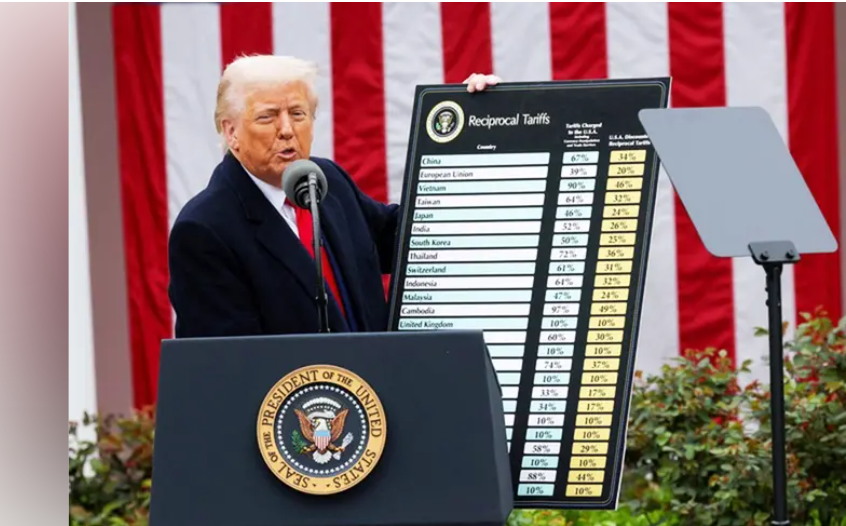On April 2, 2025, U.S. President Donald Trump announced new import tariffs targeting over 180 economies, including Vietnam.
At the event, President Trump held a board listing the specific tariff rates applied to each country. The UK, Brazil, and Singapore were assigned a 10% tariff. The European Union, Malaysia, Japan, South Korea, and India faced tariffs ranging from 20% to 26%. China and Vietnam were placed in the group of countries subject to the highest tariffs, at 34% and 46% respectively. About half an hour after presenting the tariff chart, President Trump signed the executive order to impose these tariffs.
The new executive order marks a reactivation of the “America First” policy with a two-tier tariff system. A baseline tariff of 10% applies to most imported goods, excluding Canada and Mexico—countries that have special bilateral trade agreements. A significantly higher retaliatory tariff is imposed on 60 countries deemed as “trade cheaters or imbalances,” including Vietnam.
Vietnam, under this policy, is subject to a 46% tariff on most exported goods to the U.S., including electronics, textiles, wood products, seafood, and mechanical components. This is the second-highest rate globally, only behind Cambodia (49%). Many domestic and international experts have called this rate “unrealistic.” Compared to major competitors like China (34%), India (26%), and the EU (20%), Vietnam’s tariff rate is significantly higher, severely undermining the competitiveness of Vietnamese goods in the U.S. market. According to the White House, the rationale behind this is that “Vietnam has continuously maintained an excessively high trade surplus, implemented administrative measures restricting U.S. goods, and manipulated the supply chain to circumvent tariffs on China.”
Immediately following the announcement of the executive order, Vietnam took high-level diplomatic action. On April 4, 2025, General Secretary Tô Lâm held a direct phone call with President Trump, requesting a minimum 45-day delay in policy implementation to allow for negotiation, preparation, and transition. This window would enable Vietnam to engage with the U.S. in negotiating a bilateral agreement aimed at achieving sustainable and mutually beneficial trade balance, without affecting Vietnam’s international commitments. Previously, several American billionaires had also urged President Trump to delay the tariff implementation by 90 days, citing concerns about a potential global recession and the erosion of U.S. global influence.
On April 6, Vietnam’s Ministry of Industry and Trade proposed eliminating all import tariffs on U.S. goods as a goodwill gesture to restore balance and support U.S. agricultural exports. However, the White House rejected the proposal, citing the continued existence of “non-tariff barriers.” On April 7, the Vietnamese Ambassador to the U.S. submitted an official diplomatic note protesting the policy and requesting a tariff review, but the U.S. side did not issue an official response.
Analysts believe that “this time, the Trump administration’s move was not driven purely by technical trade considerations, but by political and strategic motives—as part of a broader effort to restructure global supply chains in favor of the United States.”
In the early afternoon of April 9 (U.S. time), President Trump posted on Truth Social that more than 75 countries had contacted the U.S. government for trade negotiations and refrained from retaliation, prompting him to “allow a 90-DAY PAUSE and significantly reduce reciprocal tariffs during this period to 10%, effective immediately.” According to the White House, the general 10% tariff on nearly all imports into the U.S. would still remain in place. Pre-existing tariffs on automobiles and steel would also be maintained.
News of the 46% tariff on Vietnamese goods caused widespread disruption among Vietnamese businesses with U.S. partners. The textile and footwear sectors were particularly affected, with orders dropping nearly 30%. Some factories in Nam Dinh and Dong Nai had to rotate employee work schedules. In the electronics and components sector, suppliers for Apple and Samsung faced the risk of having their production lines relocated to India or Mexico. In the seafood sector, shrimp and pangasius fish prices surged, eroding their competitive advantage and leading to a spike in inventory.
Notably, just one day after the executive order took effect (April 9, 2025), Vietnam’s VN-Index dropped by nearly 75 points—around 7%—marking the sharpest single-day decline in over two decades. Facing mounting pressure from the U.S., Vietnam is shifting its trade and diplomatic focus toward Northeast Asia. On April 15, 2025, during a bilateral meeting in Seoul, Vietnam and South Korea committed to raising bilateral trade turnover to $150 billion by 2030 and strengthening cooperation in technology and agriculture. On the same day, General Secretary Tô Lâm hosted Chinese President Xi Jinping in Hanoi. The two sides signed a series of strategic agreements covering infrastructure development, logistics, and energy. Many experts see this as a clear signal that Vietnam is undergoing a “strategic pivot” toward deepening regional relations, rather than relying solely on the U.S.
The U.S. decision to impose a 46% tariff on Vietnamese goods is not just an economic shock but also a major test of Vietnam’s policy-making mindset and strategic direction. In the short term, the economy will take a hit. However, in the long term, if Vietnam can leverage this pressure to push trade system reforms, improve origin transparency, and diversify its trade partners, this could turn into a golden opportunity to reposition the country on the global trade map.
